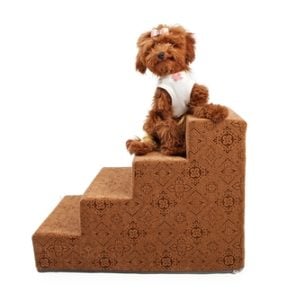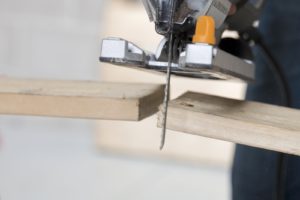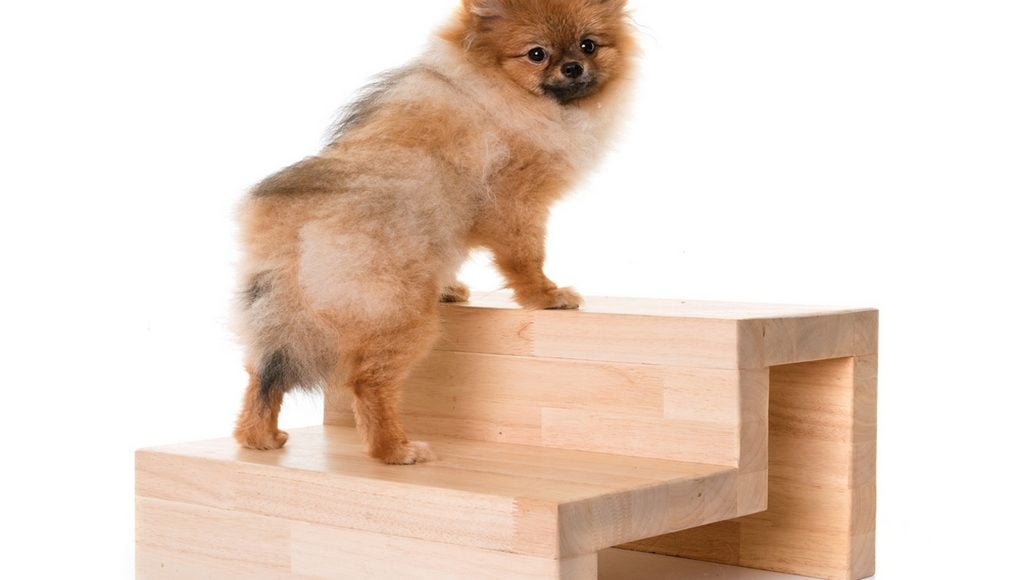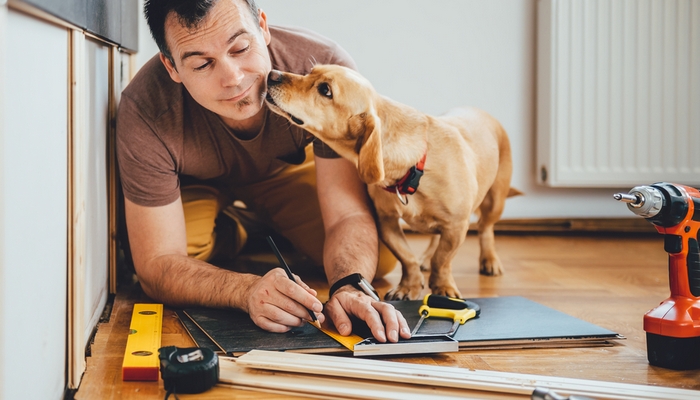Dog stairs are pretty much the same as human stairs, but cute and miniaturized. They can be a great option to help your dog get around the home. Whether he’s climbing up onto the couch for a cuddle or down a large step to get to his food, these DIY dog stairs are easy to make and much more affordable than the commercial alternatives.
Dog stairs help our dogs use their own four legs to get around rather than us having to carry them everywhere. It's one of the more popular furniture items for dogs and there are tons of different dog steps and stairs available. It contribute to limiting the risk of injury to smaller or older dogs that are always climbing around on the furniture. Or, those clumsy pups that somehow manage to fall off of the furniture!
Building your own dog stairs will allow you to customize the steps for your dog's needs and your space restrictions. You can also make DIY dog stairs with the material of your choice, so they'll blend in perfectly with your home's décor.
READ ALSO: Dog Ramps vs. Dog Stairs and Dog Steps – How Do You Decide?
DIY Dog Stairs
how to build your own DIY dog steps for bed
Do you need DIY dog stairs?
Dog stairs serve a purpose. They help dogs, whose leaping abilities aren’t what they used to be, to move around independently. Here are a few of the most common examples of ailments that may prove dog stairs to come in handy:
1. Long Term Medical Conditions
If your dog is suffering from a condition such as arthritis, or another medical issue that becomes worse over time – making adjustments to deter your dog from leaping around at all hours of the day and night can significantly increase his quality of life long-term.
2. Disabilities
For dogs with physical handicaps, a set of doggy stairs can not only aid their movement but also minimize his need for assistance from you. If you have an unusually large step to get outdoors, you can even build an overlay with a few mini DIY dog stairs that can be accessible by dogs in wheelchairs.
3. Injuries
 Broken legs, spinal injuries, recovering from surgery or even something minor like a cut paw are all examples of where a doggy staircase can come in handy. The aim here isn’t to keep your little guy in his bed all day but give him the opportunity to look past his injuries, and still have free rein of the house.
Broken legs, spinal injuries, recovering from surgery or even something minor like a cut paw are all examples of where a doggy staircase can come in handy. The aim here isn’t to keep your little guy in his bed all day but give him the opportunity to look past his injuries, and still have free rein of the house.
4. Senior
Senior dogs, like senior humans, can do with a little extra help every now and again. Just think of your Grandma and that cool walking stick – it’s more than just a fashion accessory. As well as making things for your older pups a little easier, you can also help them to stay healthy a little longer and minimize their risk of future injury.
5. Puppies
Puppies and smaller dog breeds like the dachshund might have trouble making those human sized steps or jumps onto the furniture that we take for granted. For puppies, this more or less means less face-to-couch action, and for the cute short legged breeds out there, it allows them to feel more like those larger dogs who are not troubled by these short leg challenging situations in the household.
6. Large Dogs
Sometimes an item like DIY dog stairs isn’t for the dogs benefit, but our own. For example, you probably wouldn't want to help lift a 240-pound dog onto the bed. In this case, dog stairs can help save your back.
RELATED: How Dog Stairs Can Help A Dog with Arthritis
Where can you use dog stairs?
I like to gauge this with a simple rule. If they usually jump to get onto/into/around said item, then doggy stairs can be utilized. A sofa, bed, car, bath, garden and up/down larger human sized steps are all great examples of where you can use DIY dog stairs.
They can be particularly useful when it comes to keeping your pooch off of certain furniture. Anything with a dog step is dog-friendly, and anything without is a dog-free zone.
There are a few alternatives to dog steps, for example, the doggy ramp. Ramps are just as helpful, however, depending on the height of the item, they can take up more room. The incline is particularly important to take into account as well, because some dogs will not be able to climb a steep ramp.
RELATED: 7 DIY Dog Bed Project Ideas and Guides
What to consider when building your DIY dog stairs
Preparation for building your DIY dog stairs should not be taken lightly. You need to think about a lot of different factors when deciding what materials to use and what dimensions your dog stairs are going to be.
Consider the following factors before making any definite plans:
1. Step Size
Believe it or not, in the human world, stairs have a precise and consistent height. These ergonomic sizes are based on the average step size. Even if a single step is not consistent with the rest, it can result in a trip and fall. The same will apply for your dog, so be especially careful when measuring, and cutting your materials.
2. Dog Weight And Size
 Depending on the weight and size of your pooch, you will need to build your stairs to accommodate this. If you have a multiple dog household, you may need to consider making different stairs to match your different doggy needs.
Depending on the weight and size of your pooch, you will need to build your stairs to accommodate this. If you have a multiple dog household, you may need to consider making different stairs to match your different doggy needs.
If that sounds like a little too much work or you don’t want your house to be filled with a bunch of tiny staircases, you should base the size of step off of the needs of your smallest dog.
You can use a different construction material to help make a staircase more sturdy, such as metal or wood. If you only have access to one type of material, just make sure it can adequately support your pup. Remember, if your dog is a puppy you're going to need to plan for his size when he's full grown.
3. Destroy-ability
Lego bricks could be a straightforward and fast method for creating your dog stairs, however, should your dog decide to play a little too rough on the stairs, he would be presented with a thousand tiny Lego pieces to choke on. Of course, nobody would build DIY dog stairs out of Lego bricks, but the point is, choose your materials wisely.
You need to ensure that none of the parts can get loose, so the stairs are safe if Fido decides to nibble on them. Hazards like this can be an afterthought, but depending on how clumsy your dog is or how much he enjoys to chew on your furniture, it's something you need to seriously consider.
4. Comfort
 Humans wear shoes, and in a lot of housing – where perhaps we might not always be protected by our shoes – we have carpets. When constructing your stairs, comfort is worth considering and can impact building materials or overall finish. For example, using wood could result in your dog getting splinters if you’ve not properly treated and finished your DIY dog stairs.
Humans wear shoes, and in a lot of housing – where perhaps we might not always be protected by our shoes – we have carpets. When constructing your stairs, comfort is worth considering and can impact building materials or overall finish. For example, using wood could result in your dog getting splinters if you’ve not properly treated and finished your DIY dog stairs.
Anything that can cause injury or even discomfort to your animal needs to be taken care of. If you wouldn’t want to walk on it, then don’t expect your dog to think any differently about your creation. Not to mention, if your dog doesn’t want to walk on it, he’s not going to use it.
5. Height
The taller the staircase, the more steps are needed and the more space the stairs will take up. If you’re from Britain, like me, then you might have experienced the lack of consideration in height when castles were constructed. Stair cases are crazy steep, and it makes the descent a perilous one. When building your stairs, saving space in your home might be a big consideration and a nice little bonus for yourself.
RECOMMENDED: 15 Best Dog Stairs for Bed or Car
How To Build Your DIY Dog Stairs
One of my favorite (and one of the simplest) ways of creating dog steps is to use thick planks of wood cut to size and then layering them on top of each other. It is by far the fastest and easiest solution, especially for those with little to no DIY skills to speak of.
Materials and Tools Needed:
- wood
- saw
- glue
- sand paper
- carpet finish (optional)
Step 1: Measure Before You Cut
When you start to build your stairs, it is best to start at the top with your last step. For example, if this staircase will be used to allow your precious pup to climb onto the bed, measure the height of the bed and this will give you the height of your final step.
Take into consideration your dogs step size, as we mentioned previously, divide the height into an equal amount of steps. For example, if the height is 100 cm and you need a step size of roughly 25 cm then you will end up with four levels of step.
Step 2: Cut Your Materials To Size
 Step depth is just as important as step height. So make sure that your dog’s paws will fit with plenty of room to spare but not so much that he can’t walk one step at a time.
Step depth is just as important as step height. So make sure that your dog’s paws will fit with plenty of room to spare but not so much that he can’t walk one step at a time.
Now, seeing as we’re going with the simple approach of layering/stacking thick wooden planks, you only need to make two measurements and a single cut for each step. This will allow you to define how deep each step will be and make sure to stack enough wood to get the desired height per step.
Step 3: Glue Everything Together
Once you have all your pieces cut to size, you need to start gluing your planks of wood together. I suggest sticking one at a time and waiting for each to dry before moving onto the next to avoid any slipping during the stacking process.
Step 4: Sand Down Sharp Edges
For added comfort and peace of mind for both your dog and your shins, I reccomend sanding all of the sharp corners down to a nice rounded edge.
Step 5: Optional Carpet Finish
For those that want to add even more comfort or perhaps blend their stairs into their existing decor, gluing a carpeted finish to the stairs is a fast and easy way to go. Especially if you still have some cuts remaining from your last carpet fitting. If not, you might be able to ask a local carpet store if they have some off cuts that you can have!
There you have it, an extremely fast and cheap DIY dog staircase that will help your pup roam freely around your home! For another quick and easy way to build DIY dog stairs, check out the short video below.
RELATED: DIY Pet Gates Project – How to Make a Dog Gate at Home
Here's a good video to help you with your DIY dog stairs project:
Final Thoughts
 While some dog owners may see doggy stairs as an unnecessary luxury for lazy little lapdogs, they are in fact one of my favorite solutions for allowing disabled, sickly, old, or ridiculously short dogs to get around the home with comfort and ease. Too many owners underestimate the damage that their dog can be doing from jumping onto and off of furniture.
While some dog owners may see doggy stairs as an unnecessary luxury for lazy little lapdogs, they are in fact one of my favorite solutions for allowing disabled, sickly, old, or ridiculously short dogs to get around the home with comfort and ease. Too many owners underestimate the damage that their dog can be doing from jumping onto and off of furniture.
Arthritis is prevalent in the canine population, and if you can spend a little time making DIY dog stairs that will help prevent your dog from suffering from this – then why not do it?! It will also help dogs prone to other orthopedic conditions, like hip dysplasia.
READ NEXT: How To Train A Dog To Use Stairs
















